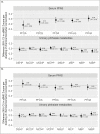Serum PFAS and Urinary Phthalate Biomarker Concentrations and Bone Mineral Density in 12-19 Year Olds: 2011-2016 NHANES
- PMID: 35511700
- PMCID: PMC9282360
- DOI: 10.1210/clinem/dgac228
Serum PFAS and Urinary Phthalate Biomarker Concentrations and Bone Mineral Density in 12-19 Year Olds: 2011-2016 NHANES
Abstract
Context: Per- and polyfluoroalkyl substances (PFAS) and phthalates are 2 families of environmental endocrine disruptors that may be associated with areal lower bone mineral density (aBMD).
Objective: To examine associations between serum PFAS and urinary phthalate biomarker concentrations and their mixtures with aBMD Z-scores in adolescents.
Design, patients, and measures: We examined serial cross-sectional data from male (n = 453) and female (n = 395) 12- to 19-year-old participants in the 2011 through 2016 National Health and Nutrition Examination Survey with measures of serum PFAS, urinary phthalate metabolites, and dual-energy X-ray absorptiometry aBMD Z-scores (total body less head). In sex-specific models, we used linear regression to examine associations of individual PFAS and phthalate biomarkers with aBMD Z-scores, and Bayesian kernel machine regression to examine the association of the overall PFAS/phthalate biomarker mixture with aBMD Z-scores. We replicated the analysis, stratifying by race/ethnicity.
Results: Participants were (mean ± SD) 15 ± 2.1 years of age. In males, each doubling of serum perfluorooctanoate (PFOA), perfluorooctane sulfonate, urinary mono-isobutyl phthalate (MiBP), mono-n-butyl phthalate, and the overall PFAS/phthalate mixture was associated with a lower aBMD Z-score (eg, for PFOA: -0.24; 95% CI, -0.41 to -0.06). Serum PFOA and urinary MiBP were associated with higher aBMD Z-scores in females (eg, for PFOA: 0.09; 95% CI, -0.07 to 0.25). Findings did not differ by race/ethnicity.
Conclusions: Certain PFAS and phthalates may be associated with reduced bone mineral density in adolescent males. Bone mineral density tracks across the life course, so if replicated in longitudinal cohorts, this finding may have implications for lifelong skeletal health.
Keywords: National Health and Nutrition Examination Survey; bone mineral density; children; per- and polyfluoroalkyl substances; phthalates.
© The Author(s) 2022. Published by Oxford University Press on behalf of the Endocrine Society. All rights reserved. For permissions, please e-mail: journals.permissions@oup.com.
Figures


Comment in
-
Bone Accrual During Adolescence: Do Endocrine-Disrupting Chemicals Play a Role?J Clin Endocrinol Metab. 2022 Sep 28;107(10):e4242-e4243. doi: 10.1210/clinem/dgac391. J Clin Endocrinol Metab. 2022. PMID: 35762324 Free PMC article. No abstract available.
References
-
- CDC. Centers for Disease Control and Prevention. Fourth National Report on Human Exposure to Environmental Chemicals, Updated Tables, (January 2019). Atlanta, GA: U.S. Department of Health and Human Services, Centers for Disease Control and Prevention. https://www.cdc.gov/exposurereport/
-
- CHAP (Chronic Hazard Advisory Panel on Phthalates and Phthalate Alternatives). Bethesda, MD: U.S. Consumer Product Safety Commission, Directorate for Health Sciences; 2014. Accessed September 4, 2020. https://www.cpsc.gov/s3fs-public/CHAP-REPORT-With-Appendices.pdf

